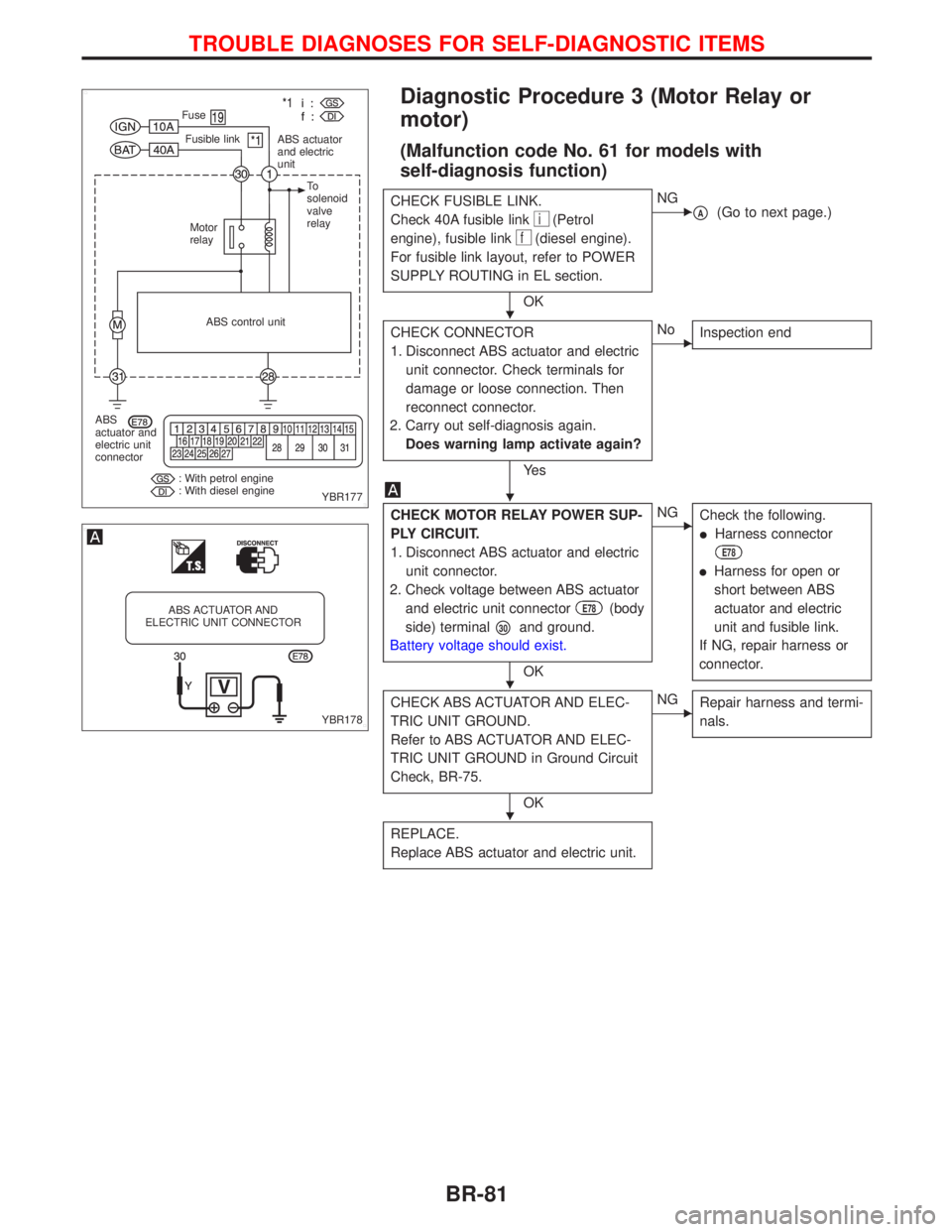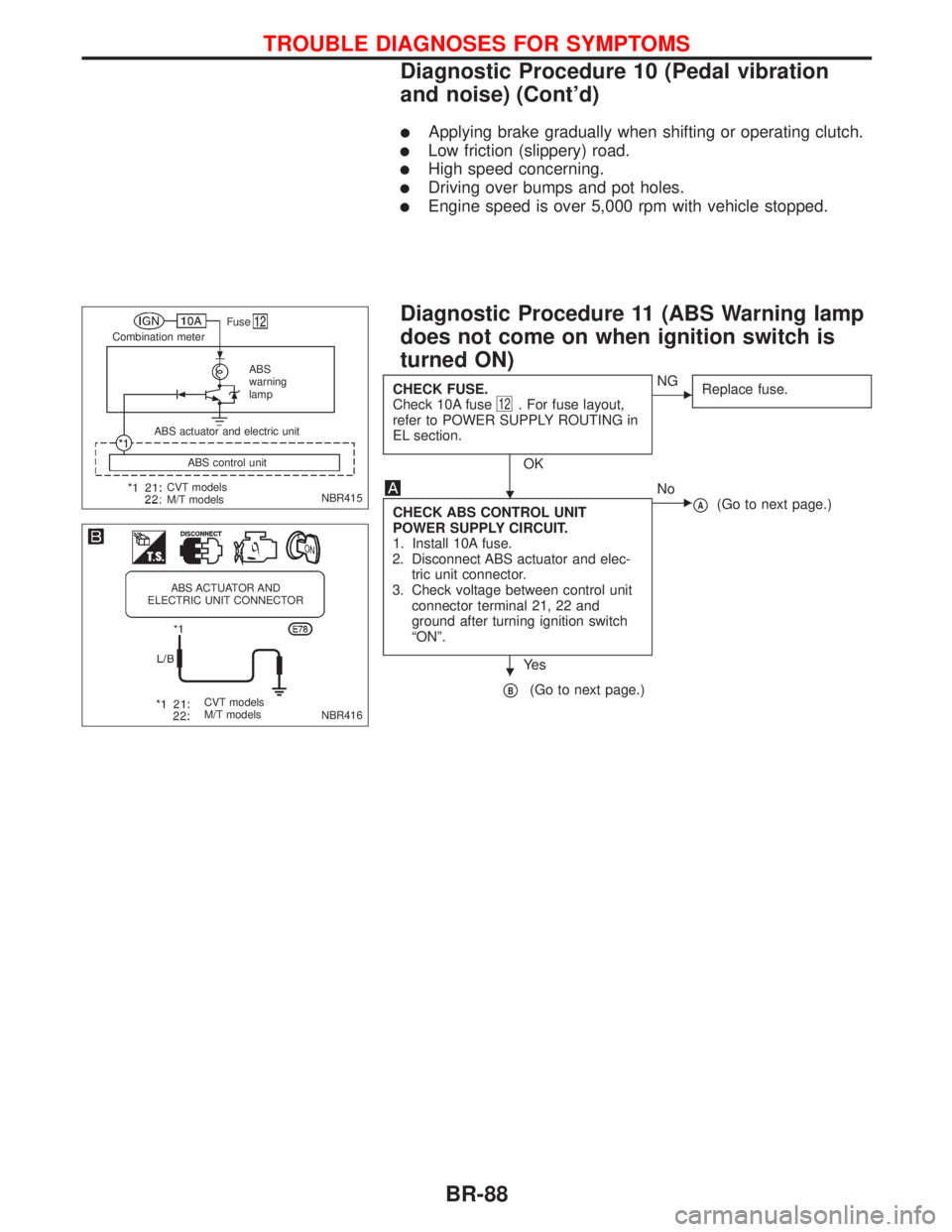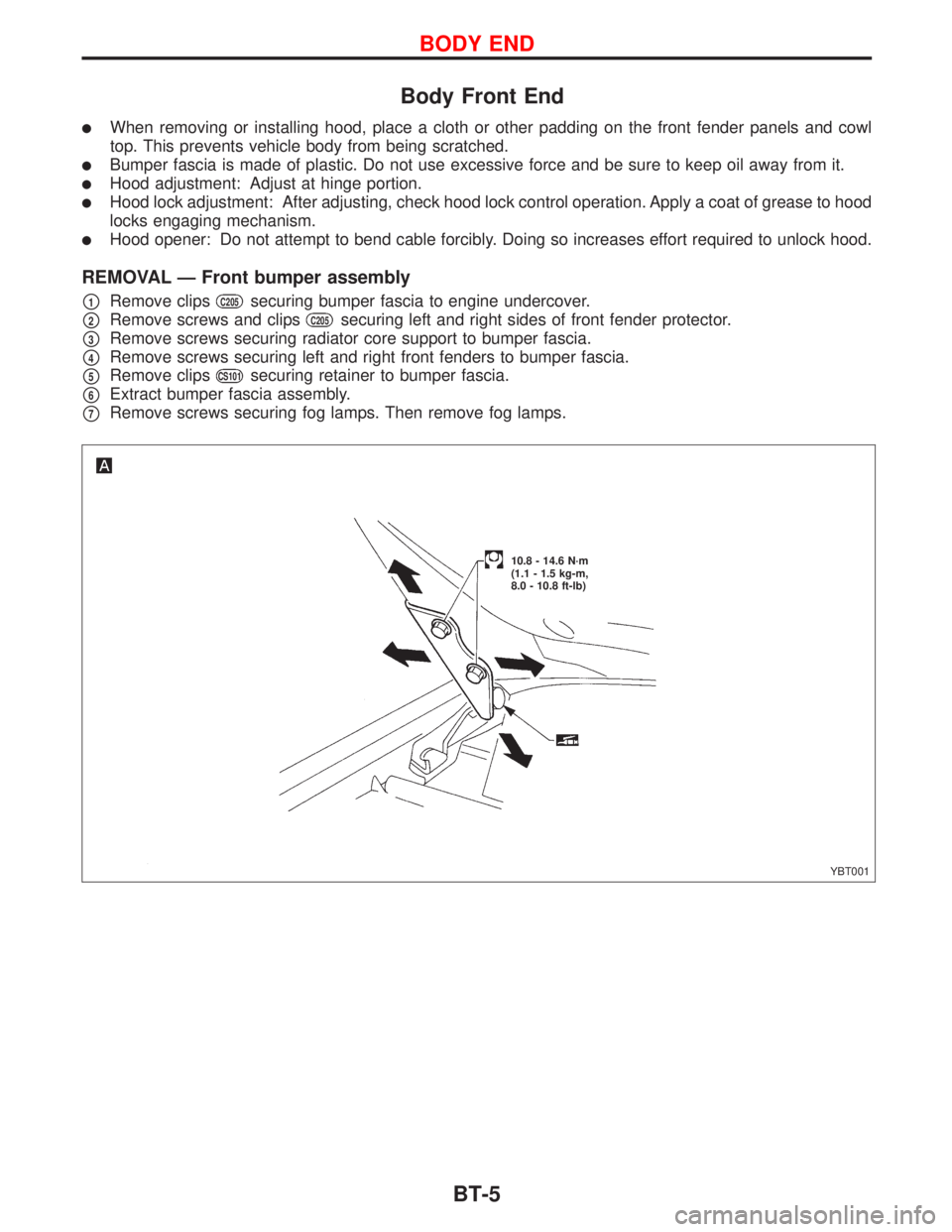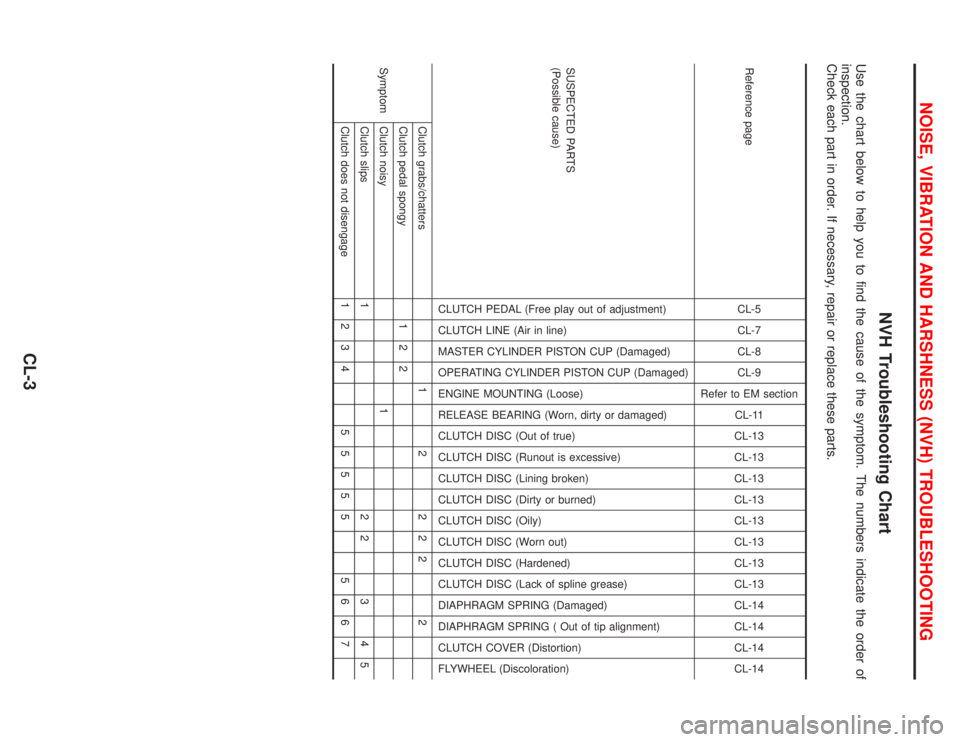Page 197 of 2267
ACTIVE TEST MODE
TEST ITEM CONDITION JUDGEMENT
FR RH SOLENOID
FR LH SOLENOID
RR RH SOLENOID
RR LH SOLENOID
Engine is running.Brake fluid pressure control operation
IN SOL OUT SOL
UP (Increase):
KEEP (Hold):
DOWN (Decrease):OFF
ON
ONOFF
OFF
ON
ABS MOTORABS actuator motor
ON: Motor runs (ABS motor relay ON)
OFF: Motor stops (ABS motor relay OFF)
Note: Active test will automatically stop ten seconds after the test starts. (LIMIT SIGNAL monitor
shows ON.)
Ground Circuit Check
ABS ACTUATOR AND ELECTRIC UNIT GROUND
lCheck resistance between ABS actuator and electric unit
connector terminals and ground.
Resistance: approximately 0W
YBR170 ABS ACTUATOR AND
ELECTRIC UNIT CONNECTOR
Trouble Diagnosis Ð General Description
CONSULT-II Inspection Procedure (Cont'd)
BR-75
Page 201 of 2267

Diagnostic Procedure 2 (ABS actuator
solenoid valve and solenoid valve relay)
(Malfunction code Nos. 41, 42, 45, 46, 51, 52, 55, 56,
63 for models with self-diagnosis function)
CHECK FUSIBLE LINK.
Check 40A fusible link
g(petrol
engine), fusible link
h(diesel engine).
For fusible link layout, refer to POWER
SUPPLY ROUTING in EL section.
OK
ENGpA(Go to next page.)
CHECK FUSE.
Check 10A fuse
19. For fuse layout,
refer to POWER SUPPLY ROUTING in
EL section.
OK
ENGpB(Go to next page.)
CHECK CONNECTOR.
1. Disconnect ABS actuator and elec-
tric unit connector. Check terminals
for damage or loose connection.
Then reconnect connector.
2. Carry out self-diagnosis again.
Does warning lamp activate
again?
Ye s
ENo
Inspection end
CHECK ABS ACTUATOR AND ELEC-
TRIC UNIT GROUND CIRCUIT.
Refer to ABS ACTUATOR AND ELEC-
TRIC UNIT GROUND in Ground Circuit
Check, BR-75.
OK
ENG
Repair harness and con-
nector.
CHECK SOLENOID VALVE RELAY
POWER SUPPLY CIRCUIT.
1. Disconnect ABS actuator and elec-
tric unit connector.
2. Check voltage between ABS actua-
tor and electric unit connector
E78
(body side) terminalp29and ground.
Battery voltage should exist.
OK
ENG
Check the following.
lHarness connector
E78
lHarness for open or
short between ABS
actuator and electric
unit and fusible link
If NG, repair harness or
connector.
REPLACE.
Replace ABS actuator and electric unit.
YBR174 Fusible link
Fuse
ABS actuator
and electric unit
To motor relay
Solenoid
valve
relay
ABS control unit
ABS
actuator and
electric unit
connector
: With petrol engine
: With diesel engine
YBR175
ABS ACTUATOR AND
ELECTRIC UNIT CONNECTOR
H
H
H
H
H
TROUBLE DIAGNOSES FOR SELF-DIAGNOSTIC ITEMS
BR-79
Page 203 of 2267

Diagnostic Procedure 3 (Motor Relay or
motor)
(Malfunction code No. 61 for models with
self-diagnosis function)
CHECK FUSIBLE LINK.
Check 40A fusible link
i(Petrol
engine), fusible link
f(diesel engine).
For fusible link layout, refer to POWER
SUPPLY ROUTING in EL section.
OK
ENG
pA(Go to next page.)
CHECK CONNECTOR
1. Disconnect ABS actuator and electric
unit connector. Check terminals for
damage or loose connection. Then
reconnect connector.
2. Carry out self-diagnosis again.
Does warning lamp activate again?
Ye s
ENo
Inspection end
CHECK MOTOR RELAY POWER SUP-
PLY CIRCUIT.
1. Disconnect ABS actuator and electric
unit connector.
2. Check voltage between ABS actuator
and electric unit connector
E78(body
side) terminal
p30and ground.
Battery voltage should exist.
OK
ENG
Check the following.
lHarness connector
E78
lHarness for open or
short between ABS
actuator and electric
unit and fusible link.
If NG, repair harness or
connector.
CHECK ABS ACTUATOR AND ELEC-
TRIC UNIT GROUND.
Refer to ABS ACTUATOR AND ELEC-
TRIC UNIT GROUND in Ground Circuit
Check, BR-75.
OK
ENG
Repair harness and termi-
nals.
REPLACE.
Replace ABS actuator and electric unit.
YBR177 Fusible link Fuse
ABS actuator
and electric
unit
Motor
relayTo
solenoid
valve
relay
ABS control unit
ABS
actuator and
electric unit
connector
: With petrol engine
: With diesel engine
YBR178
ABS ACTUATOR AND
ELECTRIC UNIT CONNECTOR
H
H
H
H
TROUBLE DIAGNOSES FOR SELF-DIAGNOSTIC ITEMS
BR-81
Page 209 of 2267

Diagnostic Procedure 9 (ABS does not
work.)
CHECK WARNING LAMP ACTIVATE.
Does the ABS warning lamp activate?
No
EYe s
Carry out self-diagnosis.
Refer to BR-67.
Go toin Diagnostic Procedure 7,
BR-86.
Note: ABS does not work when vehicle speed is under 10
km/h (6 MPH).
Diagnostic Procedure 10 (Pedal vibration and
noise)
INSPECTION START
1. Apply brake.
2. Start engine.
3. Does the symptom appear only
when engine is started?
No
EYe s
Carry out self-diagnosis.
Refer to BR-67.
CHECK IF SYMPTOM APPEARS.
Does the symptom appear when elec-
trical equipment switches (such as
headlamp) are operated?
Ye s
ENo
Go toin Diagnostic
Procedure 7, BR-86.
CHECK WHEEL SENSOR.
Check wheel sensor shield ground. For
location of shield ground, refer to wiring
diagram and ªHARNESS LAYOUTº in
EL section.
OK
ENG
Repair wheel sensor.
CHECK HARNESS CONNECTOR.
Check ABS actuator and electric unit
pin terminals for damage or the con-
nection of ABS actuator and electric
unit harness connector.
Reconnect ABS actuator and electric
unit harness connector. Then retest.
Note: ABS may operate and cause vibration under any of
the following conditions.
SAT797A Brake pedal
H
H
H
H
TROUBLE DIAGNOSES FOR SYMPTOMS
BR-87
Page 210 of 2267

lApplying brake gradually when shifting or operating clutch.
lLow friction (slippery) road.
lHigh speed concerning.
lDriving over bumps and pot holes.
lEngine speed is over 5,000 rpm with vehicle stopped.
Diagnostic Procedure 11 (ABS Warning lamp
does not come on when ignition switch is
turned ON)
CHECK FUSE.
Check 10A fuse12. For fuse layout,
refer to POWER SUPPLY ROUTING in
EL section.
OK
ENG
Replace fuse.
CHECK ABS CONTROL UNIT
POWER SUPPLY CIRCUIT.
1. Install 10A fuse.
2. Disconnect ABS actuator and elec-
tric unit connector.
3. Check voltage between control unit
connector terminal 21, 22 and
ground after turning ignition switch
ªONº.
Ye s
ENo
pA(Go to next page.)
pB(Go to next page.)
NBR415
.Fuse
Combination meter
ABS
warning
lamp
CVT models
M/T modelsABS control unit ABS actuator and electric unit
NBR416
ABS ACTUATOR AND
ELECTRIC UNIT CONNECTOR
CVT models
M/T models
H
H
TROUBLE DIAGNOSES FOR SYMPTOMS
Diagnostic Procedure 10 (Pedal vibration
and noise) (Cont'd)
BR-88
Page 219 of 2267

Body Front End
lWhen removing or installing hood, place a cloth or other padding on the front fender panels and cowl
top. This prevents vehicle body from being scratched.
lBumper fascia is made of plastic. Do not use excessive force and be sure to keep oil away from it.
lHood adjustment: Adjust at hinge portion.
lHood lock adjustment: After adjusting, check hood lock control operation. Apply a coat of grease to hood
locks engaging mechanism.
lHood opener: Do not attempt to bend cable forcibly. Doing so increases effort required to unlock hood.
REMOVAL Ð Front bumper assembly
p1Remove clipsC205securing bumper fascia to engine undercover.
p2Remove screws and clipsC205securing left and right sides of front fender protector.
p3Remove screws securing radiator core support to bumper fascia.
p4Remove screws securing left and right front fenders to bumper fascia.
p5Remove clipsCS101securing retainer to bumper fascia.
p6Extract bumper fascia assembly.
p7Remove screws securing fog lamps. Then remove fog lamps.
YBT001
10.8 - 14.6 N´m
(1.1 - 1.5 kg-m,
8.0 - 10.8 ft-lb)
BODY END
BT-5
Page 274 of 2267
lAll dimensions indicated in figures are actual ones.
lWhen using a tracking gauge, adjust both pointers to equal length. Then check the pointers and gauge
itself to make sure there is no free play.
lWhen a measuring tape is used, check to be sure there is no elongation, twisting or bending.
lMeasurements should be taken at the center of the mounting holes.
lAn asterisk (*) following the value at the measuring point indicates that the measuring point on the other
side is symmetrically the same value.
lThe coordinates of the measurement points are the distances measured from the standard line of ªXº,
ªYº and ªZº.
Engine Compartment
MEASUREMENT
SBF874GB Imaginary base line
Front axle center Vehicle center
ªZº: Imaginary base line
[200 mm below datum line
(ª0Zº at design plan)]
YBT038 Unit: mm
BODY ALIGNMENT
BT-60
Page 281 of 2267

NVH Troubleshooting Chart
Use the chart below to help you to find the cause of the symptom. The numbers indicate the order of
inspection.
Check each part in order. If necessary, repair or replace these parts.
Reference pageCL-5
CL-7
CL-8
CL-9
Refer to EM section
CL-11
CL-13
CL-13
CL-13
CL-13
CL-13
CL-13
CL-13
CL-13
CL-14
CL-14
CL-14
CL-14
SUSPECTED PARTS
(Possible cause)
CLUTCH PEDAL (Free play out of adjustment)
CLUTCH LINE (Air in line)
MASTER CYLINDER PISTON CUP (Damaged)
OPERATING CYLINDER PISTON CUP (Damaged)
ENGINE MOUNTING (Loose)
RELEASE BEARING (Worn, dirty or damaged)
CLUTCH DISC (Out of true)
CLUTCH DISC (Runout is excessive)
CLUTCH DISC (Lining broken)
CLUTCH DISC (Dirty or burned)
CLUTCH DISC (Oily)
CLUTCH DISC (Worn out)
CLUTCH DISC (Hardened)
CLUTCH DISC (Lack of spline grease)
DIAPHRAGM SPRING (Damaged)
DIAPHRAGM SPRING ( Out of tip alignment)
CLUTCH COVER (Distortion)
FLYWHEEL (Discoloration)
SymptomClutch grabs/chatters 1 2 2 2 2 2
Clutch pedal spongy 1 2 2
Clutch noisy 1
Clutch slips 1 2 2 3 4 5
Clutch does not disengage 1 2 3 4 5 5 5 5 5 5 6 6 7
NOISE, VIBRATION AND HARSHNESS (NVH) TROUBLESHOOTING
CL-3